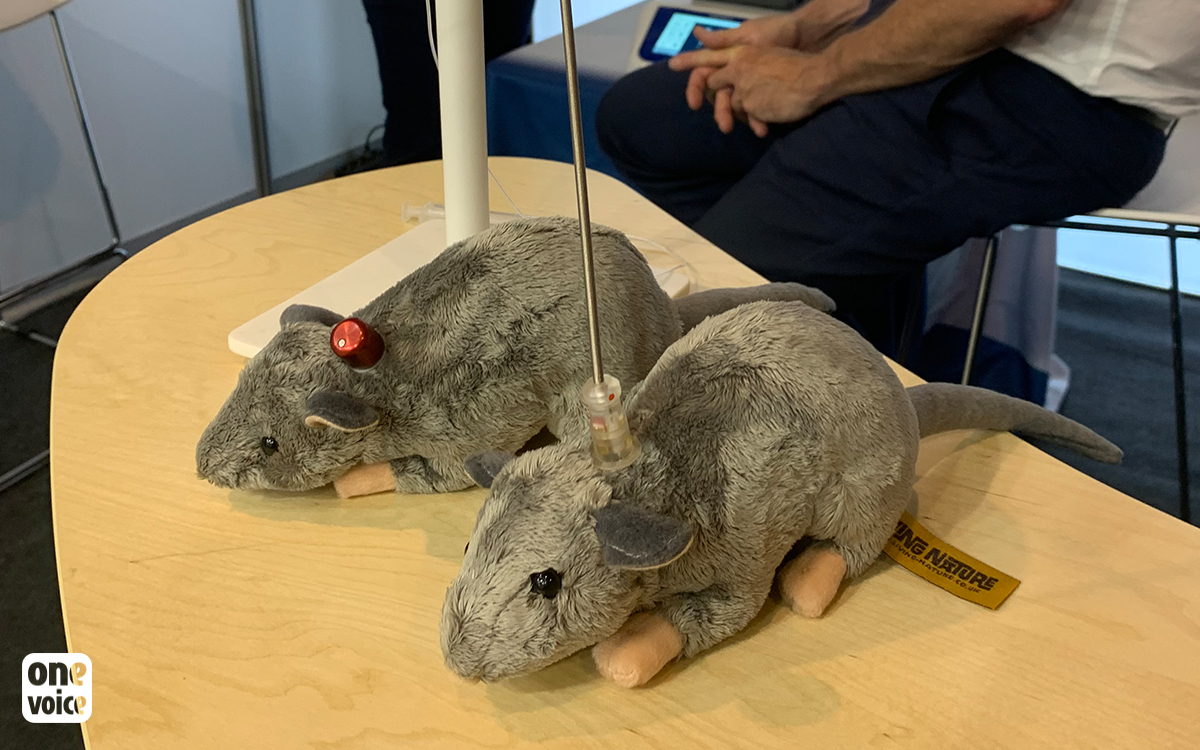

The animal testing industry makes propaganda
We often have a habit of representing people who practice animal testing as monsters void of empathy. However, the situation is more complex: lobbyists and the industry seem to manipulate public opinion just as well as those who practice animal testing.
Wednesday 15 June in Marseille. In the halls at the international FELASA 2022 congress there is the same happy look as any other conference, the same cheery networking fed by petits fours and pleasantries. The speeches are generally well done, to the point that you would almost agree with the comments on the importance of animal welfare and the rhetorical fallacies repeated excessively.
But if we read between the lines, that which is implicit and remains unsaid is blindingly obvious: we are talking about exploitation, about discrimination so anchored in society that it is no longer even considered an injustice. All year long, these people keep animals captive and make them suffer in various ways.
Propaganda even in magazines
Among the material suppliers and financers present at the congress, we find Ellegaard in particular, a producer of Göttingen minipigs. These minipigs are used to a great extent in various research domains. On the Ellegaard website, you can see a chain of images of cheerful piglets: playing with a ball, being stroked by a laboratory technician and so on. Never a dead pig, never one drop of blood, never the slightest sign of suffering.
Even in their professional journal and in their pamphlets, the rural images follow one after the other and are much the same, except when it talks about experimentation itself. To illustrate a model of heart failure, we must make do with a diagram taken from a scientific article. The worst images that we could find were, in number 60 of the business’ magazine, a tiny image of a blood test and a sutured foot.
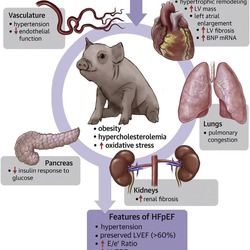
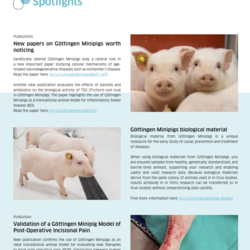
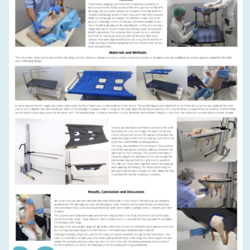 Sterilised footage
Sterilised footage
The pamphlet from the company BASi is of the same ilk: on one side, animals with fuzzy edges cut on a computer and superimposed on a white background; on the other, as a demonstration of the use of sale cages, a figurine of a pig. The photographs were not even available on the manufacturer website.
And there is still the same problem among other manufacturers, who prefer to show inhalation towers and other restraint devices without animals, and to offer drawings or diagrams to illustrate these procedures.
Regarding Fine Science Tools (whose acronym FST is also the acronym for forced swim test), we only see surgical instruments in their catalogue and on their stand. We may be told that these instruments are the same as those used in human surgery – but we allow ourselves to doubt this when it comes to the “decapitation scissors”.
Nauseating indecency
Further, the business representatives smile and joyfully allow us to take a photo of the cuddly toy rats that are particularly cute. Their skulls are kitted out with various instruments and they seem to be there to draw attention to the stand.
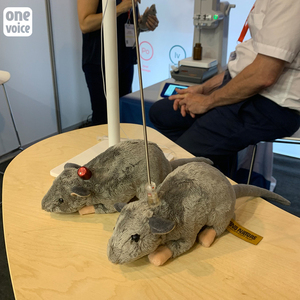 And the publicity goes even further in indecency. Tecniplast sings praises for its cages with a photograph that is reminiscent of the famous Creation of Adam painting, showing God and man’s fingers touching. Except it is the gloved finger of someone who practices animal testing and a rat’s paw, pressing against the plastic box in which it is going to spend its life. This rat has certainly been killed by now.
And the publicity goes even further in indecency. Tecniplast sings praises for its cages with a photograph that is reminiscent of the famous Creation of Adam painting, showing God and man’s fingers touching. Except it is the gloved finger of someone who practices animal testing and a rat’s paw, pressing against the plastic box in which it is going to spend its life. This rat has certainly been killed by now.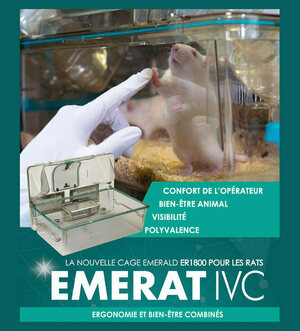
Buttering them up
And it is not over. Because in addition to masking the reality of the experiments and make believing in a special and positive relationship between animals and people who participate in their exploitation, the industry does not forget to present it all as humanitarian work.
In the Afstal journal, Marshall (who we know in France for its dog breeding for laboratories) depicts a small girl embracing her grandmother. The message written is aimed at those who practice animal testing: “Thank you, your work with the ferrets creates cures and saves lives”. Evidently, they are not talking about the ferrets’ lives.
These are not monsters – but their actions are monstrous
With all of this propaganda surrounding us, we can understand that researchers and laboratory technicians think that their work is commendable. To tell the truth, even without this propaganda, we know that the prospect of helping to advance science helps people to put their empathy towards animals to one side.
So there is no need to talk about the violent people and sociopaths (who exist in the animal testing environment as they do elsewhere): force of habit and lack of empathy can prevent almost anyone from seeing the horror of their own actions.
Also, when a document entitled a caring career manages to pass off the image of a person cleaning a plastic box full of mice amongst around ten other identical boxes on a shelf as benevolent, it has to be said that the fight is far from over.
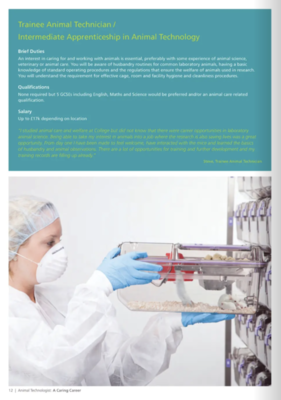
This article is the third in a series which will present different aspects of the FELASA 2022 congress:
- Transparency and communication strategies in animal testing
- Language elements and rhetorical fallacies in animal testing
- The animal testing industry makes propaganda
- The ethical short-sightedness of animal testing
- Will there soon be more primates in laboratories?
Translated from the French by Joely Justice